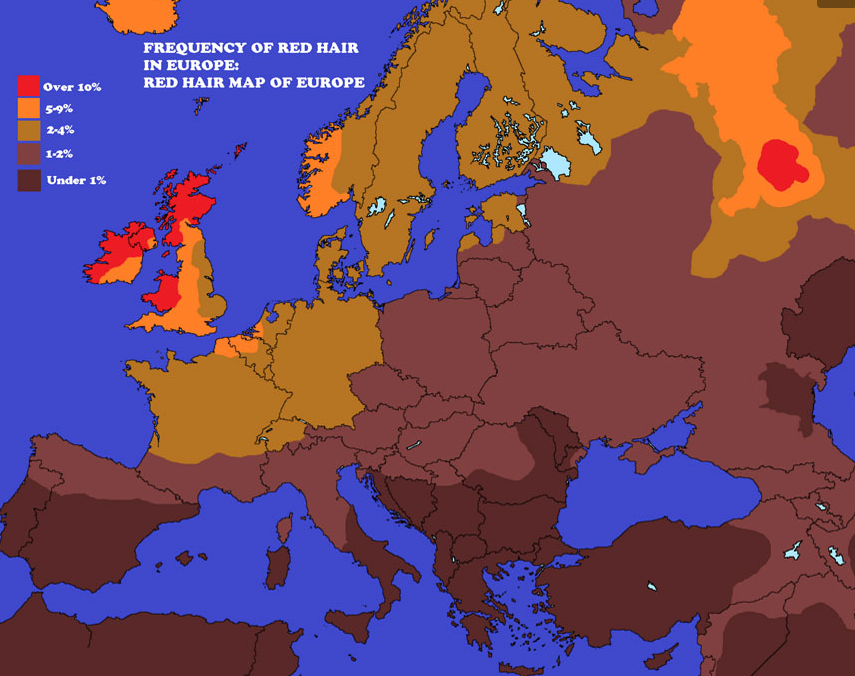Map of Red Hair Frequency in Europe


David Chen
Data Visualization Specialist
David Chen is an expert in transforming complex geographic datasets into compelling visual narratives. He combines his background in computer science ...
Geographic Analysis
What This Map Shows
The map titled "Frequency of Red Hair in Europe" visually represents the distribution of individuals with red hair across various European regions. It highlights the areas where this unique hair color is most prevalent, shedding light on genetic diversity and historical migration patterns. Interestingly, while red hair is often associated with Celtic heritage, its distribution reveals a more complex tapestry of ancestry and genetics across the continent.
Deep Dive into Red Hair Genetics
Red hair is a striking trait that is primarily linked to a variant of the MC1R gene. This gene influences melanin production, resulting in the distinctive red hue. Globally, only about 1-2% of the population has red hair, but in certain regions of Europe, particularly in the British Isles, the frequency can soar to as much as 10-13%. Ever wondered why red hair is so prevalent in these areas? The answer lies in both historical and environmental factors.
The genetic mutation associated with red hair is believed to have provided some advantages in northern climates, where sunlight is scarce. Individuals with red hair and lighter skin are more capable of producing vitamin D in low-light environments, which could have made them more adaptable to life in northern Europe. This adaptation might explain why Ireland and Scotland have some of the highest concentrations of red-haired individuals. In fact, approximately 40% of the population in Ireland carries the recessive gene for red hair, leading to a vibrant display of this unique trait.
Interestingly, red hair is not limited to the British Isles. In parts of Scandinavia and the Eastern European regions, such as Poland and Russia, there are also notable populations of red-haired individuals, albeit at lower frequencies than in the British Isles. The genetic diversity in these regions is influenced by centuries of migration and intermarriage, which has introduced the MC1R variant to various populations.
Regional Analysis
When examining the map, you can see a stark contrast between regions. For instance, the highest concentrations of red hair are found in Ireland and Scotland, where local folklore and cultural identity are intertwined with this unique trait. The west coast of Scotland, particularly, is known for its high incidence of red hair, making it a focal point of study for geneticists.
In contrast, countries like Spain and Italy show significantly lower frequencies of red-haired individuals. This can be attributed to different historical migrations and the genetic makeup of these populations. The Mediterranean regions, characterized by warmer climates and different genetic backgrounds, do not support the MC1R mutation as robustly as their northern counterparts.
Interestingly, the map also reveals pockets of red-haired individuals in parts of France and Germany. In France, the Brittany region, known for its Celtic roots, exhibits higher numbers of red-haired individuals, while in Germany, the prevalence aligns with areas that have historical ties to Celtic tribes.
Significance and Impact
Understanding the distribution of red hair in Europe goes beyond mere curiosity; it offers insights into human genetics, migration patterns, and cultural identity. This genetic trait serves as a window into the past, revealing how populations have adapted to their environments over centuries.
Moreover, the fascination with red hair has cultural implications as well. In folklore, red-haired individuals often occupy roles that are both revered and feared, symbolizing strength and otherness. This duality can influence social dynamics and even impact how individuals with this trait are perceived in society today.
Currently, there's a growing interest in genetic studies that explore why certain regions have a higher prevalence of red hair. With advancements in genetic testing and awareness, researchers are increasingly able to trace ancestry and migration patterns, providing a richer understanding of human history.
As we look to the future, the significance of red hair may continue to evolve. With globalization and migration, the frequency of red-haired individuals may shift, blending genetic lines and creating new cultural narratives. The map not only serves as a visual representation of red hair distribution but also as a reminder of the intricate connections between genetics, environment, and cultural identity in Europe.
Visualization Details
- Published
- September 30, 2025
- Views
- 48
Comments
Loading comments...